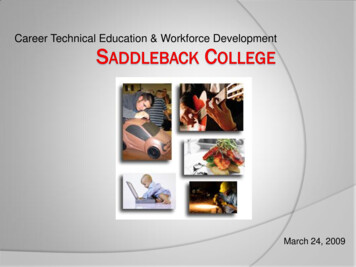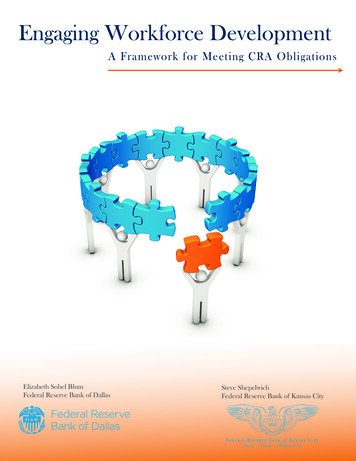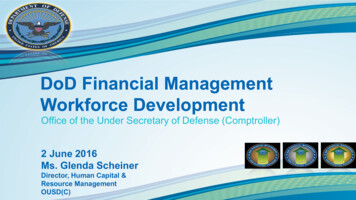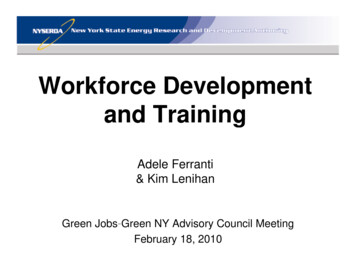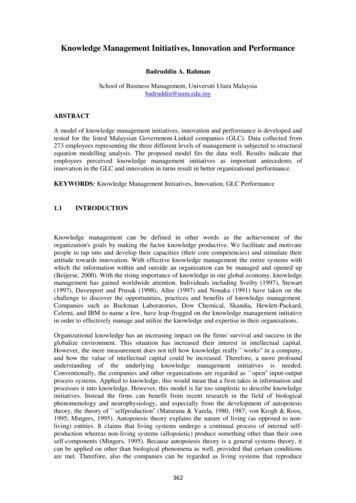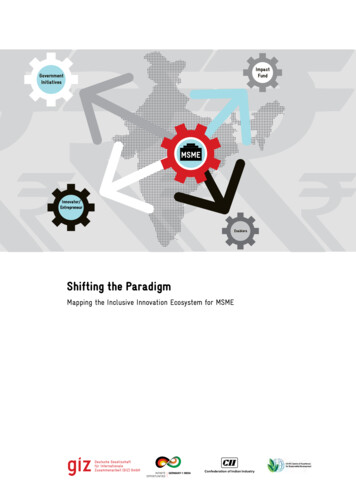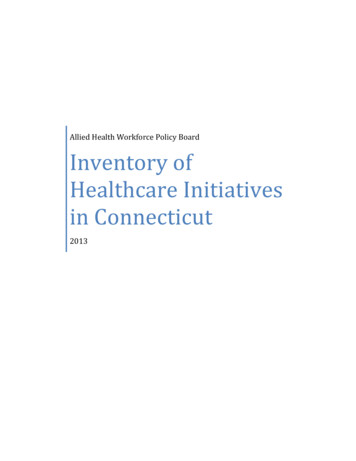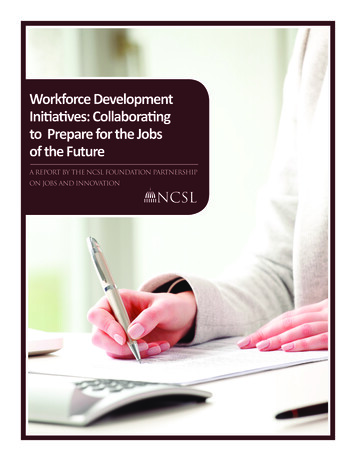
Transcription
Workforce DevelopmentInitiatives: Collaboratingto Prepare for the Jobsof the FutureA report by the NCSL Foundation Partnershipon Jobs and Innovation
ACKNOWLEDGEMENTSIn 2012, the National Conference of State Legislatures (NCSL) formed a new public/private partnershipto examine the role of state policymakers in job creation and innovation through the NCSL Foundation.The partnership supports NCSL’s ongoing efforts to improve the quality of information available to statepolicymakers.A key goal of the partnership is to improve the dialogue among state legislators, business representatives andother organizations interested in state policy decisions. The partnership convened a National Jobs Summitto bring state policymakers together with the private sector partners in September, 2013 and is publishing of aseries of issue briefs on state policies related to job creation and innovation.This brief is one of three.Other briefs in this series include:The State Role in Rebuilding the Manufacturing SectorInnovations in State Entrepreneurship PolicyThese works could not have been accomplished without the invaluable assistance and expertise of our partners.LEGISLATOR ADVISORY COMMITTEE MEMBERS:Project Chair: Representative John Davis, TexasProject Vice-Chair: Senator Buddy Carter, GeorgiaSenator Anna Fairclough, AlaskaSenator Joyce Elliott, ArkansasRepresentative Dan Pabon, ColoradoSenator Nancy Detert, FloridaSenator Toi Hutchinson, IllinoisRepresentative Brent Yonts, KentuckySenator Richard Madaleno, MarylandAssemblywoman Lucy Flores, NevadaSenator Nellie Pou, New JerseyRepresentative Craig Horn, North CarolinaRepresentative Mark Johnson, OregonDelegate Richard Anderson, VirginiaRepresentative Ross Hunter, WashingtonSenator Robert Plymale, West VirginiaLEGISLATIVE STAFF ADVISORY COMMITTEE MEMBERS:Staff Chair: Jim Landers, Fiscal and Management Analysis, IndianaPaul Steenhausen, Legislative Fiscal Analyst’s Office, CaliforniaDavid Zin, chief economist, Senate Fiscal Agency, MichiganBill Marx, chief fiscal analyst, House Fiscal Analysis Department, MinnesotaStacey Preis, Joint Committee on Education, MissouriJonathan Ball, Legislative Fiscal Analyst, UtahPRIVATE SECTOR PARTNERS:American Society of Civil EngineersAmgenComp TIADellHoneywellNCSL FoundationToyotaWalmartWells FargoNCSL STAFF:Julie Bell, Education ProgramCaroline Carlson, NCSL FoundationSuzanne Hultin, Education ProgramMichele Liu, Education ProgramLuke Martel, Fiscal Affairs ProgramMandy Rafool, Fiscal Affairs ProgramAron Snyder, Fiscal Affairs Program
WorkforceDevelopmentInitiatives:Collaboratingto Preparefor the Jobsof the FutureSlow recovery from the Great Recession has underscored the shift from anindustrial-based economy to one thatis knowledge-based. Often there is alack of skilled, educated workers to fillan increasing number of available jobs.Yet filling these new jobs would bringan increased return on investment to state economies,as they usually require a high level of skill and therefore pay well, generating higher revenues for states. Aperson with a college degree earns about twice as much— 25,000 extra annually — than someone with only ahigh school diploma. That translates into an extra 1million in earnings over a lifetime. Jobs increasinglyrequire some form of postsecondary education and,according to research from the Georgetown Center onEducation and the Workforce, by 2020, 65 percent ofjobs will require education or training beyond highschool.1 While many of these jobs will require at least abachelor’s degree (35 percent), an almost equal amountwill require only some college, a certificate, or an associate’s degree (30 percent). At the current rate of collegecompletion, however, the nation will fall short of thatby 5 million degrees.2Past workforce development initiatives focused onjob search and placement need to mirror the shiftingeconomy and focus on longer term improvements toeducation and training for high-skilled jobs. In fact, according to the McKinsey Global Institute, by 2020 thecountry could be short as many as 1.5 million peoplewith the necessary middle to high skills to fill jobs, andPERCENT OF JOBS REQUIRING POSTSECONDARYEDUCATION (CERTIFICATE AND ABOVE) BY MEGA71%-76%65%-70.9%FL55%-64.9%
Workforce Development Initiatives: Collaboration to Prepare for Jobs of the Future4have 6 million low skilled, likely unemployed, workers.3This brief highlights various state and industry-ledworkforce development initiatives. All approach workforce development in different ways and target variouspopulations. They range from aligning K-12 and postsecondary education to workforce needs, to alternativeways of delivering basic skills, to re-training the underemployed and unemployed, to training specific skillsfor specific industries. All the initiatives, however, aremodels of collaboration among several state agenciesand business partners to develop workers with the skillsneeded to continue to grow businesses and state economies.Re-Envisioning Systems of Education, BasicSkills and Workforce TrainingWashington I-BEST 4In 2005, Washington’s State Board for Communityand Technical Colleges (SBCTC) found that only 4 percent to 6 percent of adult students in basic skills classesultimately went on to enroll in college-level courses.Additionally, it found a “tipping point” where studentswho completed one year of college-level courses andearned a degree or certificate markedly increased theirearnings within five-years, compared to other adult basic education students. In response to these findings,SBCTC created the Integrated Basic Education andSkills Training (I-BEST) program to increase the rate ofstudents reaching this tipping point and advancing tocollege-level courses and completing a postsecondarycredential.I-BEST moves students quickly through the basicskills courses by combining them with college-level technical education courses, allowing students to immediately start earning credits toward a credential. Programsare designed with a specific sequence of courses, leadingdirectly to a degree or certificate in high-demand jobs.When developing I-BEST programs, local labor marketneeds were analyzed along with potential wages for students who complete the programs. Eighty-eight percentof all I-BEST programs are in the fields of health care,education, manufacturing and business currently. Thereare more than 150 programs throughout Washington’s34 community and technical colleges.Basic skills instructors and technical education facultydevelop and teach I-BEST courses collaboratively andare required to be in class together at least 50 percent ofthe instructional time. In this way courses combine traditional basic skills with college level concepts, allowingstudents to apply their learning to the professional/technical education immediately. For example, an I-BESTcourse in business technology integrates basic skills andprofessional education by having students create a busi-National CONFERENCE of State Legislatures 2014ness portfolio. Basic writing skills and word processingskills are integrated to write a proposal, and basic mathskills and spreadsheet skills are integrated to develop abudget.Approximately 3,000 students a year enroll in I-BESTprograms, and a large portion are undereducated andfrom the low-skill workforce. Sixty-two percent are female, 41 percent are students of color, and 21 percentspeak English as a second language. Additionally, almosthalf the students (47 percent) have at least one child.A cohort of I-BEST students was evaluated over fouryears to determine progress toward meeting the program’s goal of taking students to the “tipping point.”Twenty-four percent of students completed one yearof college level courses and earned a credential, while12 percent made no progress. Compared to traditionalbasic skills students, I-BEST students were three timesmore likely to earn college credits and nine times morelikely to complete a credential. I-BEST students also reported an average of 2,300 more in earnings annually.The I-BEST program has become a nationally recognized success for aligning basic skills education withworkforce needs. Through support from private foundations, SBCTC has provided technical assistance toseveral other states looking into developing similar programs.Michigan No Worker Left Behind 5The major economic downturn in Michigan duringthe recession left hundreds of thousands of workers unemployed, with many losing long-held, well-paying jobs.Research by the Michigan Commission on Higher Education and Economic Growth concluded that the state’sfuture competitiveness required doubling the numberof workers with a postsecondary degree or credential tokeep pace with a labor market that now required different skills. In 2007, Governor Jennifer Granholm announced the No Worker Left Behind (NWLB) initiativewith the goal of reaching 100,000 participants withinthree years. With the support from federal WorkforceInvestment Act funds, the program provides low-wage,underemployed and unemployed workers with 5,000a year, for up to two years, to pay for tuition, fees andother educational expenses at community colleges orother educational institutions.A key aspect of NWLB is that the skills and credentials being funded align with business demands. Morethan 40 Michigan Skills Alliances helped build a strongindustry partnership around the state, relaying theneeds of employers. The program changed Michigan’sworkforce development strategy by focusing resourceson helping workers obtain new skills and credentialsmatching workforce need. It helped move the state awayfrom short-term job search and placement services, to-
erWorkforce Development Initiatives: Collaboration to Prepare for Jobs of the FuturePERCENTWORKINGAGE POPULATION (25-64) WITH ASSOCIATES DEGREE OR HIGHERPercentWorkingAgePopulation(25- tof6IN 2011 AND PERCENTOF JOBS REQUIRING POSTSECONDARY EDUCATION BY ificateorabove)vi(CERTIFICATE OR shingtonWestVirginiaWisconsinWyoming0ward longer-term investment in training and obtainingcredentials. In 2009, Michigan’s Department of Energy,Labor and Economic Growth reported that 75 percentof those who had completed the program had retainedor obtained a job. And by 2010, the three year mark, theprogram had enrolled 148,808 participants, outpacingthe state’s goals.Oregon Career Pathways Initiative 8Launched in 2004 with five colleges, and now expanded to all 17 community colleges in the state, the OregonCareer Pathways Initiative seeks to increase the numberof Oregonians with certificates or associate’s degrees andequip them with the skills to fill the middle-skill jobdemand in the state. The program also aims to ease thetransition between high school and community collegeand encourage further educational attainment, whetherthrough higher degrees or stackable certificates. This ispart of the state’s larger 40-40-20 Goal, which states that40 percent of the workforce will have four-year degreesor higher, 40 percent will have a postsecondary certificate or associate’s degree, and 20 percent will hold a highschool diploma or equivalent and be ready to enter theworkforce by 2025. The initiative is focused on ensuringthat all Oregonians have access to and complete shortterm certificate programs that can lead to either higherlevels of degrees or immediate employment in occupations such as healthcare, manufacturing and business.The Oregon State Board of Education, in 2007, approved Career Pathway Certificates of Completion(CPCC) which are short-term certificates that containcourses linked to competencies that qualify students foran entry-level job. Since then, more than 240 CPCCshave been developed through collaboration betweenemployers and colleges. The programs are flexible and“student-centered,” allowing students to enter the program at several points, depending on their skill level.Between 2008 and 2012, more than 5,000 of these shortterm certificates were awarded. More recently, the statedeveloped Career Pathway Roadmaps website has beenlaunched with more than 350 “roadmaps” or plans forstudents seeking educational goals and career attainment. These roadmaps include all the courses needed,as well as certificates and associate’s degrees offered atthe state’s community colleges, to pursue specific fields.Industry Leaders Training Future WorkersNational CONFERENCE of State Legislatures 2014
Workforce Development Initiatives: Collaboration to Prepare for Jobs of the Future6Toyota Advanced ManufacturingTechnician Program9With the shift toward a global manufacturing marketalong with a large group of technically skilled workersretiring, North America Toyota began to evaluate howto recruit new workers and what skills they would needto keep Toyota competitive worldwide. Toyota officialsquickly found the problem of having to replace a “retirement bubble” of workers was compounded by the factthat the next generation of workers needed a more comprehensive set of skills than those of the retiring worker.Toyota identified three main problems: 1) a lack ofhighly skilled applicants; 2) a lack of basic educationskills; and 3) a negative perception of manufacturing.There were not enough sufficiently skilled workers in thepool Toyota could draw from. In fact, the No. 1 unfilledjob opening during the Great Recession was for “skilledtechnicians.” From the numerous applicants Toyota received, only 5 percent were qualified. This was largelybecause applicants had a single skill — electrician, mechanic, welder or a programmer. What Toyota neededwas a next generation, multi-skilled worker who had theknowledge to perform a combination of all these jobs.Toyota leaders decided that to remain competitivethey could not wait for large, systemic change withinthe education system. They needed to be the catalystfor change. So, they re-imagined their next generationteam member into someone with many skills (electrical,mechanics, fabricator); strong math and reading capabilities; aptitude for fast technical learning; a proficiencywith digital media; strong problem solving skills; effec-National CONFERENCE of State Legislatures 2014Low Skill Jobs Require high school diploma or lessMiddle Skill Jobs Require some college, certificate or associates degreeHigh Skills Jobs Require bachelor’s degree and highertive verbal and written communications; good interpersonal skills; and the ability to be a team worker.With this vision of the next generation skilled technician, Toyota then created a path to get these workerstrained. The result was the Advanced ManufacturingTechnician Program. It combines classroom instructionwith on-site training at a local Toyota manufacturingfacility, resulting in an associate’s degree in applied science upon completion. Each program is held in a partner community college near a Toyota or other appropriate partner manufacturing facility.Students receive paid work experience along with anintensive high-tech curriculum, general education skills,and instruction in workplace culture and behavior. Theprogram runs for five semesters, with students in classor work for 40 hours a week, allowing them to completeit within 18 months. Students work two to three daysa week, and earn between 17 and 19 an hour, or as
Workforce Development Initiatives: Collaboration to Prepare for Jobs of the Futuremuch as 30,000 a year to cover education expenses.The hands-on experience allows students to better immediately integrate their classroom learning.The remaining days are spent in the classroom wherestudents receive general education and technical classessuch as motor mechanics and welding. Technical classesare held in spaces similar to places these students willwork in upon completion. The realistic look and feelof a factory keeps Toyota from having to provide “retraining” students, as they have to for those graduatingfrom traditional community college programs.There are Advanced Manufacturing Technician Programs in Kentucky, West Virginia, Indiana, Mississippiand Texas, and all of them except Kentucky are in theprocess of recruiting students to begin in the fall of2013. Kentucky’s program began in 2010, partneringwith Bluegrass Community and Technical College, andhas graduated three classes to date. Other companieshave joined with Toyota to provide manufacturing training, including 3M, Central Wheel Manufacturing andGR Spring.Students who have completed the program have allpassed the Toyota technical written exam. Additionally,average test results have been above passing in all fourtechnical areas, compared to candidates coming intoToyota without the AMT Program. They typically passonly one or two areas. The result thus far has been theEndnotes1Anthony Carnevale, Recovery: Projections of Jobs andEducation Requirements Through 2020 (Washington, D.C.:The Georgetown University Center of Education and theWorkforce, 2013).2Carnevale, 2013.3James Manyika, Susan Lund, Byron August, & SreenivasRamas, Help Wanted: The Future of Work in AdvancedEconomies (n.p.: McKinsey Global Institute).4John Wachen, Davis Jenkins, and Michelle Van Noy, HowI-BEST Works: Findings from a Field Study of WashingtonState’s Integrated Basic Education and Skills Training Program (New York, NY: Community College Research Center,2010).5Larry Good, Michigan’s No Worker Left Behind: LessonsLearned from Big-Picture Workforce Policy Change (Washington, D.C.: National Skills Coalition, 2011).multi-skilled technicians Toyota envisioned.Pennsylvania Industry Partnership10In 2006, lawmakers in Pennsylvania passed legislationallocating 20 million in state revenue and 10 millionin state-designated federal Workforce Investment Act resources to develop partnerships of employers from a single regional industry to identify common skill gaps. Thepartnerships were then charged with developing curricula and credentials needed for designated occupationsat local community colleges and WIA-funded trainingproviders. Called “Industry Partnerships,” there are nowabout 80 with 6,300 businesses receiving funding notonly from the state but from employer investments aswell. By the end of 2009, nearly 100,000 participantshad been trained through the Industry Partnership andparticipants were experiencing up to a 6.6 percent wagegain after completion of the program.The partnerships publicize particular clusters of industries with good wages and benefits, or that have thegreatest potential for economic growth or challenges togrowth or retention. These areas include manufacturing, bio-medical, business and financial services, andhealthcare and bio-medical, among other fields. Thepartnerships develop training and education programsfor workers and assist in placing dislocated workers inopen jobs with other employers within the partnerships.6Lumina Foundation, A Stronger Nation Through HigherEducation (Indianapolis: Lumina Foundation, 2012).7Carnevale, 2013.8Community Colleges and Workforce Development, Worksource Oregon, Pathways in Oregon: A Descriptive Studyof the Statewide Initiative & Initial Cohort of Completers.(March 2013)9Toyota Advanced Manufacturing Technician DevelopmentProgram information accessed from correspondence withDennis Dio Parke
low recovery from the Great Reces-sion has underscored the shift from an industrial-based economy to one that is knowledge-based. Often there is a lack of skilled, educated workers to fill an increasing number of available jobs. Yet filling these new jobs would

